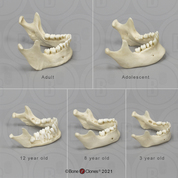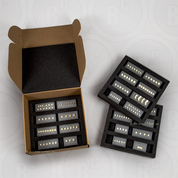-
Fields of Study
- K-12 Education
- Advanced Anatomy
- Forensics
- Physical Therapy
- Primate Locomotion
- Non-primate Locomotion
- Biological Anthropology
- Paleontology
- Bioarchaeology
- Marine-Aquarium
- Veterinary
-
Zoology
- All Zoological Items
- Endangered Species
- Skulls
- Skeletons
- Cranial Elements
- Postcranial Elements
- Eggs
- Limbs
- Teeth & Fangs
- Claws & Talons
- Brains & Endocasts
- Life Casts
- Pathology & Trauma
- Wildlife Forensics
- Sets
- Bird Sets
- Accessories
- Birds
- Mammals
- Reptiles & Amphibians
- Fish
- Sharks & Rays
- Turtles & Tortoises
- Anatomy for the Artist
- Decor
- Veterinary
- Elements
- Pathology & Trauma
-
Sets & Series
- Natural History Gift Ideas
- Decor
- Scale & Sculpture
- 3D Scanned & Printed
- Bone Boxes
- Locomotion Sets
- Forensic Sets
- Advanced Anatomy Sets
- Physical Therapy Series
- Fetal Sets
- Economy Series
- Zoology Sets
- Bird Sets
- Claw & Talon Sets
- Tooth & Fang Sets
- Primate Skull Sets
- Fossil Hominid Sets
- B.I.O.P.S.I. - Babiarz Institute
- Maxwell Collection
- Bergdorf Goodman Windows
- Accessories
- New Products
-
Our Company
- News & Specials
- Printable Handouts
- About Us
- Why Choose Bone Clones
- Bone Clones in the News
- Mission
- Contact Us
- Privacy and Security
- Frequently Asked Questions
- Testimonials
- Community Outreach
- Legal/Copyright
- Flyers
- Choosing Original Specimens
- Museum Exhibitions
- Natural History Gift Ideas
- About the Economy Series
- Acknowledgements
- Ordering & Delivery
- Warranty
- Refund/Return Policy
- Price List at a Glance
- Our Catalog
- Osteological Evaluation Reports
- About 3D Printing
- Sawyer & Maley Neanderthal Reconstruction
- Site Introduction
- Newsletter Archive
-
Human Anatomy
- All Human Anatomy
- Human Skulls
- Human Skeletons
- Head & Neck
- Postcranial Elements
- Advanced Anatomy
- Physical Therapy / Joints
- Human Brains & Endocast
- Human Life Casts
- Maxwell Museum
- Sets & Series
- Accessories
- Osteological Evaluation Reports
- Featured
- Adult Human Anatomy
- Adolescent Human Anatomy
- Child Human Anatomy
- Fetal Human Anatomy
- Fossil Hominids
-
Zoology
- All Zoological Items
- Endangered Species
- Skulls
- Skeletons
- Cranial Elements
- Postcranial Elements
- Eggs
- Limbs
- Teeth & Fangs
- Claws & Talons
- Brains & Endocasts
- Life Casts
- Pathology & Trauma
- Wildlife Forensics
- Sets
- Bird Sets
- Accessories
- Birds
- Mammals
- Reptiles & Amphibians
- Fish
- Sharks & Rays
- Turtles & Tortoises
- Paleontology
- Non-human Primates
- Forensics
All items sold on this website are replicas and are 1:1 scale unless stated otherwise. All Bone Clones® products are made in the USA. No real/natural bone is available on this site.
 ALSO SEE:
ALSO SEE:
Homo habilis OH 7 Mandible
KO-196 $189.00
1.7 MYA. The Homo habilis Mandible OH 7 was discovered by J. Leakey in 1960 at Olduvai Gorge, Tanzania, and described by Leakey, Tobias, and Napier in Nature in 1964. OH 7 was the specimen used by Leakey to establish a new species, Homo habilis, marking the beginning of the Homo line. The mandible is one of several bones found in the area, at least some of which are surmised to be from the same individual, likely a 10 to 12-year-old. The inference that the species represented by OH 7 made the Oldowan stone tools found in the Olduvai Gorge area led Raymond Dart to suggest the species name habilis or 'handy man.' Although found in a stratigraphic position in Bed I, Olduvai Gorge, near Australopithecus, Leakey argued for a new species designation on the basis of cranial capacity and tooth size and shape. Cranial capacity estimates for OH 7 have ranged from 642 to 723 cc.The adult cranial capacity of OH 7 is estimated to be 684 cc, significantly greater than that of A. africanus. However, this estimate has been the subject of some controversy because it is based on incomplete cranial bones and a projection of expected adult capacity from a value for a juvenile whose brain growth was not yet complete. The narrowness and length of the molars and premolars, in addition to the relatively large incisors, are unlike the size and shape of the teeth belonging to known australopithecines. Some scientists believe that the range of variation of specimens once attributed to Homo habilis is too great to represent a single species; consequently, more than one species of early Homo may have lived at the same time in East Africa. Another current view is that the differences among the various early Homo crania, including ER 1813 and ER 1470, fall within the range of variation of a single species.
| Scientific Name | Catalogue # | Size | Price |
| Homo habilis | KO-196 | 3" L x 2" W | $189.00 |
Related Products:
-
 Australopithecus afarensis, "Lucy", Jaw
Australopithecus afarensis, "Lucy", Jaw -
 Australopithecus anamensis Mandible - KNM-KP-29281
Australopithecus anamensis Mandible - KNM-KP-29281 -
 Chimpanzee Mandible, Male
Chimpanzee Mandible, Male -
 Human Jaw Set of 5
Human Jaw Set of 5 -
 Homo habilis Skull KNM-ER 1813 Sawyer-Deak Reconstruction
Homo habilis Skull KNM-ER 1813 Sawyer-Deak Reconstruction -
 Set of 32 Human Adult Male Teeth on Base
Set of 32 Human Adult Male Teeth on Base -
 4-year-old Human Child Deciduous Teeth, Set of 20 (on base)
4-year-old Human Child Deciduous Teeth, Set of 20 (on base) -
 The Turner-Scott Dental Anthropology System - Dental Plaque Set
The Turner-Scott Dental Anthropology System - Dental Plaque Set
Newsletter Signup
9200 Eton Ave.
Chatsworth, CA 91311 USA
© 1992-2025 Bone Clones Holdings. All Rights Reserved.
Customer Service
© 2025 BONE CLONES HOLDINGS / Made by MEV













